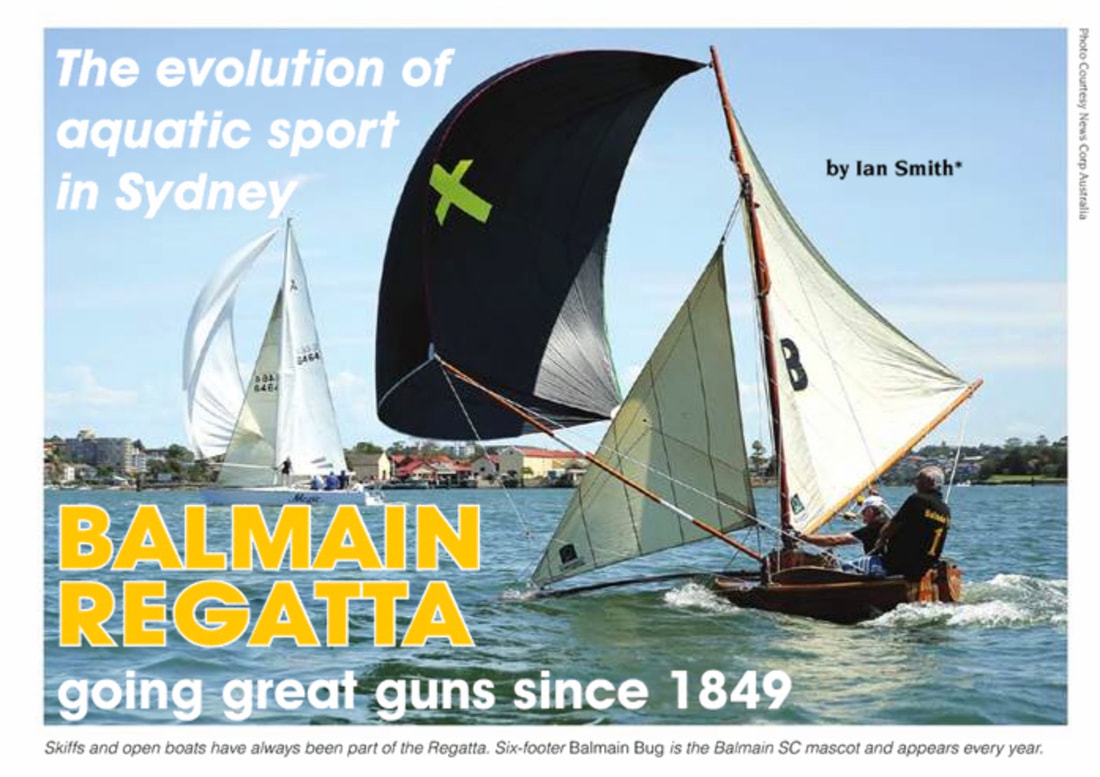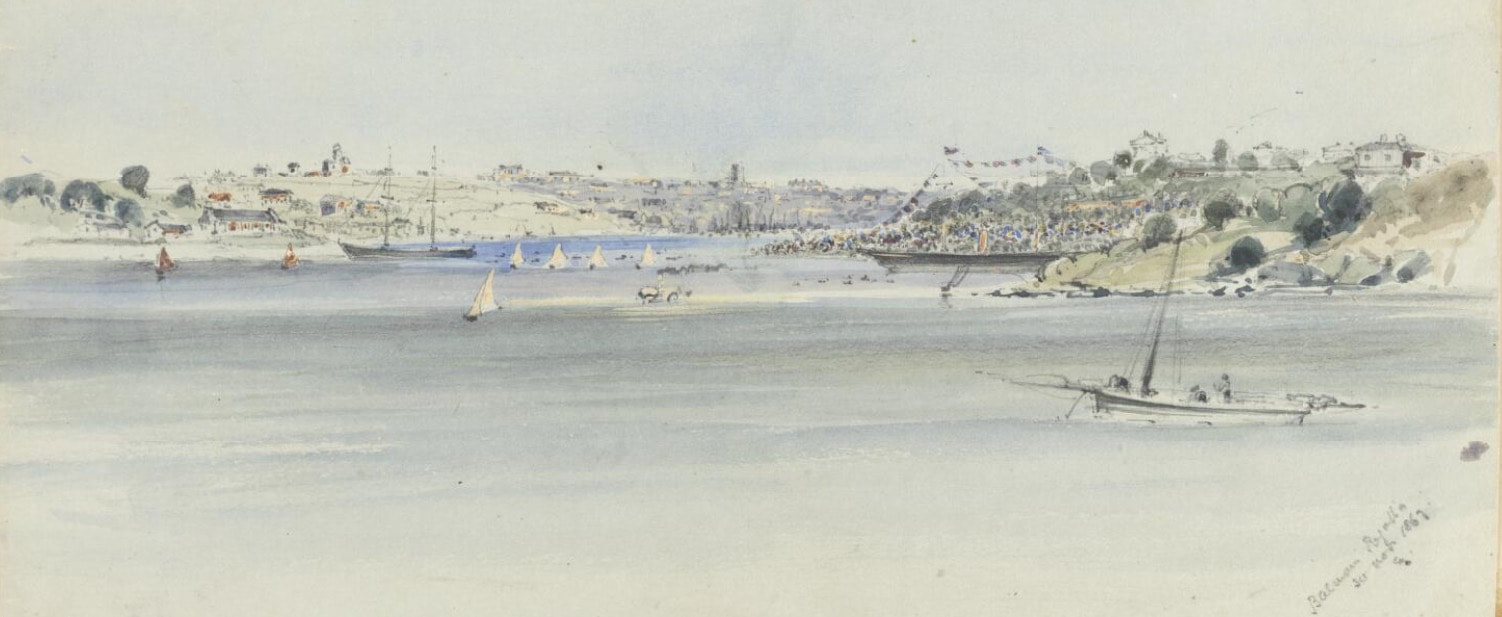This article was first published in AFLOAT magazine in October 2017. I researched and wrote it because there were many different stories circulating about the Balmain Regatta, most of which were wrong. Here is the true story.
Its not the oldest Regatta in the world (that is the Anniversary/Australia Day Regatta every January 26, since 1837), nor is it continuous (missed a few decades), but the Balmain Regatta is going great guns again, a true community event like its heyday in the 19th Century and coming up on Sunday 29 October.
First held in 1849 when a few burghers of the relatively new settlement of Balmain decided they needed a regatta to rival the Anniversary Day Regatta, it was held on the Bank Holiday of St Andrew’s Day, November 30, with the flagship schooner Rose moored between Balmain and Millers Point, off what is now Barangaroo. To put it in its historical context, the Rose set off the next day for the California Gold Rush.
There were 3 rowing races for 4-oared gigs, 2-oared skiffs and watermen’s skiffs, and 5 sailing races, two for sailing boats classified by keel length (not exceeding 13 feet and 16 feet on the keel), two for yachts over and under 5 tons, and one for ballast and wood (working) boats. Considered a big success, they ran it again the following year and it continued to grow. Eight thousand people paid ferry fares to get from the Erskine St wharf (near the Slip Inn) to Balmain to watch in 1854.
In the middle of the 19th century there were no sailing clubs in Sydney. If you wanted to race your boat, you challenged another boat for a match race (for money). Or you entered one of the regattas which were spaced over the season. As well as the Anniversary Regatta there was the Pyrmont Regatta and the Ryde Regatta (both also held in 1849), and later the Woolloomooloo Bay Regatta, North Shore Regatta, Double Bay Regatta and others that came and went. There was considerable prize money offered, the equivalent of 4-6 weeks wages for most events and even more for feature events. A flagship was always engaged from which the committee viewed the racing and held a luncheon with speeches, invitations to the Governor (who generally attended), and a brass band with dancing. It was a social highlight and everyone dressed up. The poor people lined adjacent headlands to watch. The committee was comprised of leading citizens who all subscribed considerable sums of money towards the running costs.
Its not the oldest Regatta in the world (that is the Anniversary/Australia Day Regatta every January 26, since 1837), nor is it continuous (missed a few decades), but the Balmain Regatta is going great guns again, a true community event like its heyday in the 19th Century and coming up on Sunday 29 October.
First held in 1849 when a few burghers of the relatively new settlement of Balmain decided they needed a regatta to rival the Anniversary Day Regatta, it was held on the Bank Holiday of St Andrew’s Day, November 30, with the flagship schooner Rose moored between Balmain and Millers Point, off what is now Barangaroo. To put it in its historical context, the Rose set off the next day for the California Gold Rush.
There were 3 rowing races for 4-oared gigs, 2-oared skiffs and watermen’s skiffs, and 5 sailing races, two for sailing boats classified by keel length (not exceeding 13 feet and 16 feet on the keel), two for yachts over and under 5 tons, and one for ballast and wood (working) boats. Considered a big success, they ran it again the following year and it continued to grow. Eight thousand people paid ferry fares to get from the Erskine St wharf (near the Slip Inn) to Balmain to watch in 1854.
In the middle of the 19th century there were no sailing clubs in Sydney. If you wanted to race your boat, you challenged another boat for a match race (for money). Or you entered one of the regattas which were spaced over the season. As well as the Anniversary Regatta there was the Pyrmont Regatta and the Ryde Regatta (both also held in 1849), and later the Woolloomooloo Bay Regatta, North Shore Regatta, Double Bay Regatta and others that came and went. There was considerable prize money offered, the equivalent of 4-6 weeks wages for most events and even more for feature events. A flagship was always engaged from which the committee viewed the racing and held a luncheon with speeches, invitations to the Governor (who generally attended), and a brass band with dancing. It was a social highlight and everyone dressed up. The poor people lined adjacent headlands to watch. The committee was comprised of leading citizens who all subscribed considerable sums of money towards the running costs.
The flagship for the 1867 Regatta was moored off Waterview Bay (now Mort Bay). George Penkivil Slade, NLA
By the 1870’s Balmain Regatta was a huge event. Special trains were put on to bring people from the country, and in 1879 there were 2000 people on the flagship and 1090 tickets to the luncheon were sold. The Regatta was prominently written up in the newspapers.
There were a few changes: the flagship was moved to between Longnose and Greenwich Points in 1876, and in 1881 to between Cockatoo Island and Birchgrove, and it was located in this vicinity for the rest of the life of the Regatta. The date was changed to the Prince of Wales’ Birthday, November 9, in 1868.
There were a few changes: the flagship was moved to between Longnose and Greenwich Points in 1876, and in 1881 to between Cockatoo Island and Birchgrove, and it was located in this vicinity for the rest of the life of the Regatta. The date was changed to the Prince of Wales’ Birthday, November 9, in 1868.
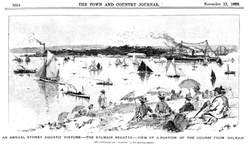
After 1881 the Regatta was held between Balmain and Cockatoo Island. The finely-dressed ladies and gentlemen are watching from Elkington Park.
The popularity and prominence of the Regatta meant that its history illustrates the evolution of aquatic sport in Sydney. The rowing events saw the evolution of competitive rowing from professional watermen’s skiffs and liveried gigs to “string-test” gigs and the invention of outriggers and sliding seats. The champion rowers’ names were famous, the Mulhalls and Greens of the 1850’s and ’60’s, Trickett and Laycock in the 1870’s, Messenger and Pearce in the 1880’s and Towns and Bishop in the 1890’s. Prizes were large and gambling was huge.
Sailing boat design changed considerably over the 19th century. The arrival of the centreboard yacht Presto in 1854 led to a controversy that took twenty years to settle (read the full story in my book The Open Boat), but led to the development of the open boat classes from which the iconic 18-footers emerged in the 1890’s.
Sailing boat design changed considerably over the 19th century. The arrival of the centreboard yacht Presto in 1854 led to a controversy that took twenty years to settle (read the full story in my book The Open Boat), but led to the development of the open boat classes from which the iconic 18-footers emerged in the 1890’s.
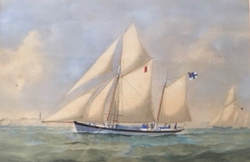
Left: For a few years the Regatta held races for coasters. This painting shows "The BOUND TO WIN 32 tons, Captain Thos. J. Shakeshaft, winning the Balmain Regatta Nov. 9th 1882." Descendant Mick Shakeshaft contacted me with this image after reading the original article in Afloat.
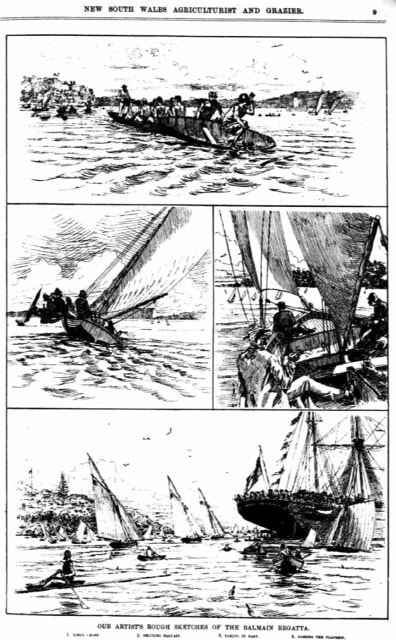
Right: The 1877 Regatta had novelty events as well as skiff, yacht and rowing races. The boat with crew swinging out centre-left is a 19-foot skiff, an ancestor of the 18's that started the tradition of huge rigs and large crews (see Chapter 2 of The Open Boat). TROVE, NLA
A regular feature of all the Regattas was novelty events. They tried tub racing and greasy pole fights but the one that lasted the longest was the gig and dinghy race. A four-oared gig and a one-man dinghy started transom to transom and the gig had to catch the dinghy (physically laying hands on the dinghy rower) within a time limit. It seemed to go either way at different regattas. Prize money was of course offered, and there are reports that the flagship passengers often had a whip around to raise a stake for a re-run. It was always the final event and alcohol may have been involved.
There were occasional runctions in the committee. They split in the late 1880’s, with the old committee holding onto the funds of 120 pounds, a considerable sum of money. In 1891 it “almost didn’t happen” and in 1892 it completely fell through. It resumed in 1893, and the Regatta of 1894 was considered the “most successful in the past decade”. Ladies sculls were introduced that year.
The leading yachts of Sydney were attending, including some that still survive like Rawhiti (now restored in NZ) and Jenny Wren, and some that didn’t survive like Sirocco which Errol Flynn put on a reef in New Guinea. By 1902 the prize money offered to the 18-footers had surpassed that offered to the previously dominant 22-footers and they were so popular there was both a morning and an afternoon race. From 1905 there was a motor-boat race.
But in the 20th century numbers were down, and the last Regatta was held in 1912. It was not the War that killed it as often suggested, it was lack of support. Prize money was down and there were plenty of other opportunities to race boats with the growth of clubs. But in 1925 a group of residents got together and started the Regatta again with a very similar format. There were rowing events with local stars such as the Pearce family, the open boat classes turned up again: the ten-footers, the 16’s , the 18’s including Britannia, Arline and Scot, and the relatively new 12-footers. The new Cadet dinghies raced, as did the new 21’ restricted class (including the Governor-General Lord Stonehaven in his Corella). Yacht numbers were down but old favourite Rawhiti turned up, as did 8-metre Norn, now rebuilt as Varg. The 1926 Regatta saw record entries and things went well for a few years. But the Depression that started in 1929 meant that after that numbers began to drop. In 1931 and 1932 the committee could not find a flagship and ran the event from Elkington Park. The last Regatta was held in 1932.
During the 1980’s Balmain shipwright Mike Ozanne organised an event he called the Balmain Vintage Yacht Race, associated with NSW Heritage Week and mostly with the Back-to-Balmain community event. Sponsored for a while by Caltex, the event raised considerable sums of money for cancer research, most notably through the Leo and Jenny Leukemia and Cancer Foundation ( now Cure Cancer Australia). Starting in 1984, Mike ran the racing from the Dawn Frazer Pool and ran it until 1991 (Lin and Larry Pardey sailed Taliesin in the 1991 event). It was never officially the Balmain Regatta but it had resurrected the idea. In 1994 the four-year-old Wooden Boat Association of NSW organised an event they called the Balmain Regatta and ran a very promising event on 16 October. The new Balmain Sailing Club which was established in the old Balmain 12-Footers building in Water Street joined in the running of the event in 1996 and has run the event continuously since then. It is a real community event in the style of the original Regatta. There are races for modern and classic yachts, modern dinghies as well as 10-foot and 18-foot historical skiffs. A watermen’s rowing race is also always a part of it. Local pubs each charter a yacht for the Pub Challenge and for some years the local Firies, Police and Ambulance also chartered yachts to race. There’s a great atmosphere, particularly at the late afternoon race presentation when the winners collect their trophies. Be a part of history this year on Sunday 29 October for the 168th anniversary and the 95th running of the Balmain Regatta (2017).
